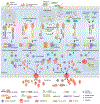A Mechanistic Understanding of Pyroptosis: The Fiery Death Triggered by Invasive Infection
- PMID: 28826530
- PMCID: PMC10245508
- DOI: 10.1016/bs.ai.2017.02.002
A Mechanistic Understanding of Pyroptosis: The Fiery Death Triggered by Invasive Infection
Abstract
Immune cells and skin and mucosal epithelial cells recognize invasive microbes and other signs of danger to sound alarms that recruit responder cells and initiate an immediate "innate" immune response. An especially powerful alarm is triggered by cytosolic sensors of invasive infection that assemble into multimolecular complexes, called inflammasomes, that activate the inflammatory caspases, leading to maturation and secretion of proinflammatory cytokines and pyroptosis, an inflammatory death of the infected cell. Work in the past year has defined the molecular basis of pyroptosis. Activated inflammatory caspases cleave Gasdermin D (GSDMD), a cytosolic protein in immune antigen-presenting cells and epithelia. Cleavage separates the autoinhibitory C-terminal fragment from the active N-terminal fragment, which moves to the cell membrane, binds to lipids on the inside of the cell membrane, and oligomerizes to form membrane pores that disrupt cell membrane integrity, causing death and leakage of small molecules, including the proinflammatory cytokines and GSDMD itself. GSDMD also binds to cardiolipin on bacterial membranes and kills the very bacteria that activate the inflammasome. GSDMD belongs to a family of poorly studied gasdermins, expressed in the skin and mucosa, which can also form membrane pores. Spontaneous mutations that disrupt the binding of the N- and C-terminal domains of other gasdermins are associated with alopecia and asthma. Here, we review recent studies that identified the roles of the inflammasome, inflammatory caspases, and GSDMD in pyroptosis and highlight some of the outstanding questions about their roles in innate immunity, control of infection, and sepsis.
Keywords: Gasdermin; Inflammasome; Inflammatory caspases; Pore-forming protein; Pyroptosis; Sepsis.
© 2017 Elsevier Inc. All rights reserved.
Figures





References
-
- Aubert DF, Xu H, Yang J, Shi X, Gao W, Li L, et al. (2016). A Burkholderia type VI effector deamidates Rho GTPases to activate the pyrin inflammasome and trigger inflammation. Cell Host & Microbe, 19, 664. - PubMed
Publication types
MeSH terms
Substances
Grants and funding
LinkOut - more resources
Full Text Sources
Other Literature Sources
Medical
Miscellaneous

